Sound Invasions with Fabio Lattanzi Antinori, Mary Sherman and Paul Thomas is a curated series of artworks which literally invade and pervade the space, bleeding out of their assigned institutional frameworks. As part of a collaboration between OCR, New York University, Steinhardt, The Metropolitan Opera House, Boston University and Goldsmiths, University of London – these internationally peer reviewed artworks are exhibited in New York City at Harvestworks. The artworks with their sounds challenge traditional institutional perspectives and provide immersive environments, critical interactions and performative spectacles which move beyond the traditional idea of what art should be and how it should be exhibited.
Challenged and challenging traditional perspectives, restrictions and expectations the artworks escape and engage, bleed out and mix with an environment in New York city that is both accepting and intolerant, welcoming and hostile. The artworks exist as a temporary carving out of space made possible by the artworks’ nature, the resistance of the artist and the persistence of the curators. Critical engagements, reflections and inward self reflections each of the artworks presents a different version of the world within which which sound is a stranger invading and pervading the space, making it its own but at the same time unfathomably escaping from it.
From July 23 to July 25, 2015
@ Harvestworks, 596 Broadway #602 NY NY 10012 • phone 212.431.1130
Office hours Mon-Fri 10am-5pm • Harvestworks facilities are wheelchair accessible
Curators: Lanfranco Aceti and Tae Hong Park
ARTWORKS
Dataflags: Lehmann Brothers, Fabio Lattanzi Antinori, 2014.
Somerset paper, screenprint, data from the last ten years of Lehman Brothers’ financial trading, electric paint, soundsystem, custom code, voice soprano (Madge).
2.40×1.40×0.05mt
The Dataflag series deals with the notion of failure in the corporate world; the first installation of the piece at the V&A in London, focused around the raise and fall of Lehmann Brothers. Much inspired by corporate flags and banners, which serve the purpose of glorifying the identity of companies worldwide, Dataflag is a screenprint on Somerset paper; when touched it tells the story of the company, by singing the last 10 years of daily financial data to the audience. It is a corporate flag of bankruptcy and failure.
The story follows a very detailed script; every time the flag is touched, a new set of numbers is announced.
These numbers are the share price of the Lehmann Brothers. The artwork, through using a language known only to a few experts in the field of finance, it narrates the ups and down that featured the company’s progress towards the terrible moment of the bankruptcy, a contemporary take on a tragedy of our times.
Eri, After Dark, Mary Sherman, 2012.
Sound: Benoit Granier
Ribbon, magnet, wooden box, ink on paper (doubling as a speaker membrane), motors, star LEDs, sound module, aluminum and microprocessor.
10”x10”x6”
Inspired by and made for Benoit Granier’s musical composition Eri1, this piece was originally constructed to be easily transported to China, where it first ‘performed’ as part of a live, electro-acoustic concert at the Beijing Conservatory in February 2012.
Brought on stage, like a present tied with a bow, Eri, After Dark is then unwrapped: The top, a Chinese-style ink painting is placed standing off to one side; while a magnet from a matching jewel case triggers a hidden reed switch, which activates the piece. (A time lag also allows the ‘stagehand ‘to sit down and put on a pair of sunglasses, foreshadowing the next sequence of events.) The flaps of the box then open one after another so that, after the first one opens, the sound module is triggered. Once all the flaps are opened, the box’s content is revealed as an intense, Pandora like light (created by a cluster of LEDs mounted inside). The piece then continues to transmit Granier’s composition through the ink painting/speaker until the next-to-the-last flap closes. Afterwards, the final flap closes as well; and, the piece is carried off stage.
1Eri an interlude from Granier’s opera Eri, After Dark is based on Haruki Murakami novel of the same title. The opera follows the life of Murakami’s fictional sisters Mari and Eri in Tokyo, where Eri is lost between two worlds – the real one she is trying to escape and the fantasy one, where she is imprisoned within a television, waiting for her sister to retrieve her.
Quantum Consciousness, Paul Thomas in collaboration with Kevin Raxworthy, 2015.
Eight channel audio multimedia installation.
A visual/sonic installation that immerses the viewer in quantum phenomenon. Quantum Consciousness is an audio-visualisation of atomic data which indexes the quantum “movement” of an electron. This project delivers an aesthetic and immersive experience that places the viewer inside the virtual superposition of a sub-atomic particle (i.e. its field of probability). This audiovisual experience establishes a metaphor and indexical map of human thought. The quantum spin of the electron here mapped is serving as the conduit for the form of the sensory stimuli of the work. The broader significance of Quantum Consciousness concerns the possibility of non-human, computational intelligence commingling with human consciousness. This link stems from the fact that the “material” of the electron and its quantum behaviour is the basis of the possibility of quantum computation.
Quantum Consciousness is in the visualization of the co-emergence of thought-data (viewer) and quantum-data (electron). The scientific research informing the work was conducted in collaboration with Assoc. Professor Andrea Morello. Dr.Morello’s current research looks at controlling the spin of electrons and nuclei for the development of the processor in quantum computer. The experiment makes visible and audible the spin of the superposition of a phosphorous electron that has been bombarded by microwave signals.The paradox of the quantum superposition (best articulated in the Schrodinger’s Cat – thought experiment) exists as an actual and empirical condition in which an electron occupies multiple positions in space simultaneously, but none specifically.
The scientific data for this project is generated from a microwave signal which transforms a reading of Richard Feynman’s (1982) paper on the birth of the quantum computer. The link between the quantum computer, consciousness and artistic expression is presented via the installation through the co-emergence of thought and quantum conditions. Quantum Consciousness is thus an experiment in the imaging and materialising of impossible states of quantum matter and the co-emergence of human consciousness.
Realized in collaboration with and support of Professor Andrea Morello, and Dr Juan Pablo Dehollain Lorenzana Quantum Nanosystems, UNSW.
ARTISTS’ BIOS
Working across a range of mediums including sculpture, print and interactive installations, Fabio Lattanzi Antinori‘s work examines the language of power and control of corporate systems and its effect on the belief systems of the individual. Through his practice he aims to explore the mystical and almost supernatural mechanism by which the dominant political and economic power shapes reality and ultimately informs notions of faith and trust in the society at large.After studying with Marina Abramovic at the PS1 Summer School in New York (2012) Fabio Lattanzi Antinori graduated from Goldsmiths (2013) with an MFA in Computational studio Arts (distinction). He had a key solo show at the Museum für angewandte Kunst (Vienna, 2013); selected group shows comprehend Pi Artworks (London, 2015), Kaunas Biennial (Kaunas, 2015) Sound Images Data (New York, 2015), Florence Trust (London, 2015), Guest Projects (London, 2015), Museum of Contemporary Cuts (on-line, 2015), V&A London (London, 2014), Beers Contemporary (London, 2013), Open Data Institute (London, 2012) and Watermans Arts Centre (London, 2015 and 2014). Fabio was selected for the SPACE CoLAB residency (London, 2015), East London Printmakers residency (2015), the Guest Project residency (London, 2015) and the Florence Trust residency (London, 2014). His participation in the Sounds Images Data show is generously supported by the Arts Council and British Council, through the Artist International Development Fund (2015). Selected talks and conferences include The Standard Model (Goldsmiths, 2015), Kaunas Biennial (Kaunas, 2015), Ual London (London, 2014), Bucharest Biennial (Bucharest 2014), Centre for Creative Collaboration (London 2013) and the V&A (London, 2013). He lives and works in London.
Mary Sherman (www.marysherman.org) is a visual artist and professor at Boston College in the Fine Arts Department and at Northeastern University in the College of Professional Studies’ Digital Media Program. In 2010, she also served as the interim Associate Director of the MIT’s Art, Culture and Technology Program (ACT), was an artist in residence at MIT in Mechanical Engineering (from 2002-2003) and is the founding director of the artist-run, non-profit TransCultural Exchange, for which she has curated numerous global exhibitions, including two of which received awards from the Northeast Chapter of the International Art Critics Association. An active artist, she proposes to “remove painting from the wall and reinvent it in the realm of space, time, and sound…[which] despite its canny conceptualism… ultimately coalesces into a lush, sensual experience.” (Cate McQuaid, The Boston Globe). Recipient of two Fulbright Senior Specialist Grants (Istanbul and Taipei) and additional residences at such institutions as CAMAC (France) and the Taipei Artist Village, her works have been shown at Taipei’s Kuandu Museum of Fine Arts, Boston’s Cyberarts Festival, Trondheim’s Norwegian University of Science and Technology, Kunsthalle Mainz, Frankfurt, Shanghai’s Zendai MoMA, Vienna’s WUK Kunsthalle, Beijing’s Central Conservatory and New York’s Trans Hudson Gallery, among others.
Dr. Paul Thomas is Associate Professor and Director of the Fine Arts program at UNSW Art and Design. Thomas initiated and is the co-chair of the Transdisciplinary Imaging Conference series 2010, 2012 and 2014. In 2000, as founding director, he instigated of the Biennale of Electronic Arts Perth 2002, 2004. Thomas is a pioneer of transdisciplinary practice and work takes not only inspiration from nanoscience and quantum theory, but actually operates there. Thomas’s current research ‘Quantum Consciousness’ is based on the work by Associate Professor Andrea Morello, Quantum Nanosystems, UNSW, looking at the visualizing and sonifying the electrons superposition in the development of quantum computing. Thomas has exhibited nationally and Internationally his pervious nano art work ‘Nanoessence’ which explored the space between life and death at a nano level and ‘Midas’ was researching at a nano level what is transferred when skin touched gold. His current publications are ‘Nanoart; The immateriality of art’, ‘Relive Media Art Histories’, co-edited with Sean Cubitt and ‘Interference Strategies’, co-edited with Lanfranco Aceti and Edward Colless.

